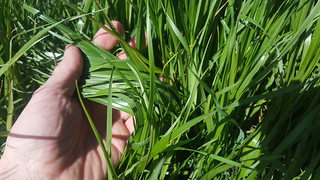Annual ryegrass difficult to control in pastures when it’s not wanted
May 16, 2018
Annual ryegrass difficult to control in pastures when it’s not wanted
Fast Facts:
- Annual ryegrass has good forage quality
- But not desirable wanted in all pasture systems
- Difficult to control, but here are some tips
(419 words)
PHOTOS available for download: https://flic.kr/p/25RBLer& https://flic.kr/p/27efaar
FAYETTEVILLE — Annual ryegrass in the pasture — if you love it, keep it. If you hate it … well, that may be a problem.

Division of Agriculture photo by Dirk Philipp
A cool season grass, annual ryegrass has very good forage quality for early grazing and is part of productive forage and grazing systems in many areas of the South. But it may not be the right choice for some pasture systems, said Dirk Philipp, said associate professor of animal science and forage researcher for the University of Arkansas System Division of Agriculture.
“The typical annual ryegrass can be a menace in newly established pastures or that producers like to renovate or keep in specific perennial forage crops,” Philipp said.
Annual ryegrass is prolific, Philipp said, because it will grow vigorously in spring to complete its annual life cycle. Also, Arkansas’ climate is perfect for it and it creates vast seedbanks that will persist for years or even decades.
“Annual ryegrass can be a problem in all kinds of pastures with either cool season or warm season grass,” Philipp said.
To control annual ryegrass in existing fescue fields, Philipp said, stock early to prevent seed head development. “Short-term, heavy stocking may help reduce ryegrass forage mass,” he said.
Philipp said to avoid overgrazing these fields because it may result in weakened fescue stands that are not ready for heavy grazing. That could result in gaps that could be populated by weeds or the unwanted ryegrass.
In newly established fescue pastures, Philipp recommends brush-hogging to keep the fast-growing annual ryegrass from growing tall and developing seedheads.
In bermudagrass fields, Philipp said, there’s normally a window in March and early April when the bermudagrass is dormant and annual ryegrass can be chemically controlled. That window may be shorter in areas of the South where winters are mild.
Philipp said annual ryegrass may not be a problem in grazed bermudagrass pastures because the bermudagrass is competitive. But in dedicated hay operations, annual ryegrass is undesirable, especially when the seedheads show up in hay baled in June or later.
When establishing new perennial pastures, Philipp recommends:
- Keep track of the history of your field’s uses and forages;
- If selecting a field for a specific pasture, keep that history in mind;
- Annual ryegrass seed is variable for a long time, so be prepared for ryegrass to show up after tilling or disking; and
- If a ryegrass problem is know, field preparation may have to be initieated 12 months before the anticipated planting date to minimize ryegrass occurrence during the year of establishment.
About the Division of Agriculture
The University of Arkansas System Division of Agriculture’s mission is to strengthen agriculture, communities, and families by connecting trusted research to the adoption of best practices. Through the Agricultural Experiment Station and the Cooperative Extension Service, the Division of Agriculture conducts research and extension work within the nation’s historic land grant education system.
The Division of Agriculture is one of 20 entities within the University of Arkansas System. It has offices in all 75 counties in Arkansas and faculty on five system campuses.
Pursuant to 7 CFR § 15.3, the University of Arkansas System Division of Agriculture offers all its Extension and Research programs and services (including employment) without regard to race, color, sex, national origin, religion, age, disability, marital or veteran status, genetic information, sexual preference, pregnancy or any other legally protected status, and is an equal opportunity institution.
By Fred Miller
Arkansas Agricultural Experiment Station
U of A System Division of Agriculture
Media Contact: Fred Miller
Communication Services
U of A Division of Agriculture
(479) 575-5647
fmiller@uark.edu
Related Links